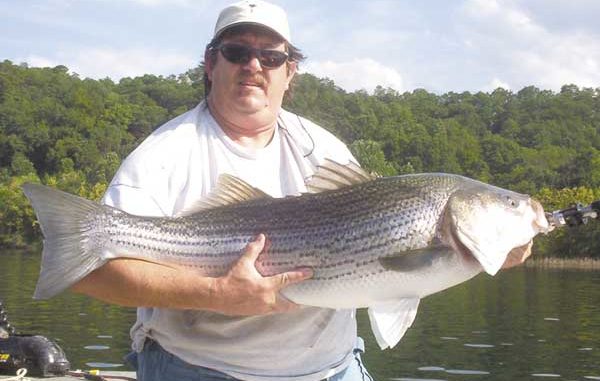
Think striped bass are too sophisticated to eat cut bait off the bottom? If so, you’re missing some hot fishing at Lake Hartwell.
Warren Turner, president of the Striped Bass Conservation Coalition, was lecturing a group of striper fishermen one day.“Here’s how you tell when a fish over 30 pounds is on the rod,” Turner said. “The rod doesn’t bow down — it twists down and pulls straight out.”
If someone should know how big striped bass act on the rod, it’s Turner. He’s well known as the figurehead of all things freshwater striper-oriented across the country. Before founding the National Striped Bass Association, which recently reorganized as the SBCC, Turner rose in the ranks as a tournament fisherman breaking several club records for the Greenville-based Striper Kings.
Working in conjunction with biologists from the S.C. Department of Natural Resources, Turner also developed a livewell system designed to keep stripers alive and healthy so they could be released alive after tournament weigh-ins. He has coordinated donation of brood fish for the state’s hatcheries and addressed the state legislatures on issues concerning stripers.
Oh, by the way, he is also known as a formidable fisherman. Chances are when he’s fishing for stripers, he’s using cut bait.
When and why
“I’m often asked what is the best time to cut-bait fish for stripers,” Turner said. “My favorite time is from March until August, and my second favorite time is from August until March if conditions are right.”
On Lake Hartwell in june, stripers typically move back out of the feeder creeks where they migrate during the spring in response to spawning urges. By late May and June, fish will be working their way back toward deeper water as surface temperatures rise, with plenty of time and opportunity to rebuild fat reserves by eating — a lot.
This results in frequent raids on baitfish schools anywhere stripers can pin them down. Mid-lake humps and points that taper off into deeper water are top choices. It’s pretty common for smaller males to tear into baitfish schools, while the bigger males and females shadow the schoolies, mopping up. This means that any fresh bait on the bottom is likely to be eaten.
“If you want to catch good numbers of large striped bass, fish over 10 pounds, my money is on cut-bait fishing, especially during the summer,” he said.
Setting up
Turner said that boat position is critical to putting out a successful spread of cut baits.
“Once I’ve located an area I want to fish, I’ll use marker buoys to mark the position before I anchor. I use them to mark where I want my anchors to be as well as where I want the boat to be positioned,” Turner said.
“I use two anchors with about 500 to 700 feet of rope on each one. You need that much rope out to properly position and secure the boat when fishing in deep water — anywhere from 40 to 100 feet deep, depending on which part of the summer you’re fishing in.”
To properly anchor, Turner uses one anchor off the bow and one off the stern. Each has a 6- to 10-foot length of chain to help secure the anchor and not chafe the rope against bottom structure.
For years, Turner lived by the old paper graphs and made notes on the rolls he kept for later reference. Now, modern liquid-crystal graphs are just as accurate — if not more accurate — than the old paper graphs, and Turner relies upon them to determine the lay of the bottom structure before setting up.
“I don’t believe that you must mark fish in order to catch fish,” he said. “However, when I mark fish, I usually catch fish quicker. Remember that you are marking a relatively small portion of the bottom, and it is usually the area behind you — if you’re moving.”
Turner applies a “shotgun approach” to cut-bait fishing, using a large number of rods to get lots of scent in the water. The idea is to mimic a fresh shad kill by marauding stripers.
“I usually put out 24 rods when fishing cut bait in a tournament,” he said. “If you don’t have rodholders set up to hold your rods securely, you will lose some rods.”
Chumming
In order to draw stripers into his baits, Turner chums. He uses fresh cut baits or baits frozen and preserved from past outings. To rejuvenate the frozen baits, Turner will place fresh cut baits on top of them, letting the fresh bait drip into the frozen pieces.
“I like to chum once I’m set up for either live-bait or cut-bait fishing,” Turner said. “If I’m fishing live bait, they’re usually beneath the boat, so I let the chum fall down around the boat.”
“When fishing cut bait, I throw the chum out to where the baits are — but not beyond them. I’m setting up a chum perimeter just inside the circle of hooked cut baits. That way a hungry striper has to swim past a hooked bait to get to the chum. I usually add chum to the water about every two hours, with about two dozen fresh baits cut into very small pieces, about the size of my thumbnail.”
Cut-bait rig
Another important feature of cut-bait fishing is a sliding “Carolina rig” that will anchor the bait to the bottom, yet still allow the line to slide around. To keep from throwing the rigs into structure, Turner marks any potential snags with a marker and casts near but not into the structure.
“On the end of each rod, I use a line rigged with a swivel and a 2-ounce egg sinker above the swivel. I throw the lines out from my boat in a 360-degree circle, as far away from the boat as I can without getting into any submerged structure.”
“When a fish hits, I simply hold on until it comes to the surface before trying to bring it to the boat,” Turner said. “That way, I get to fight it out away from the boat, which makes it much easier to net.”
“Cut-Bait Kid” hints
Turner is not the only Lake Hartwell fisherman whose had success with “cut bait-and-wait” tactics. The Appalachian Striper Club boasts a second cut-bait aficionado in Randy Brown, the club’s tournament committee chairman, who has earned the above nickname.
Brown provides some additional insights into cut-bait tactics for Hartwell stripers.
“As for bait, well, you can use almost anything that bleeds, but the most productive baits I’ve found are members of the herring family such as blueback herring and skipjack herring,” Brown said.
Another favorite is gizzard shad, but Brown said the best thing to do with the larger shad is put the fish’s innards on the hook and use the rest for chum.
There is debate over which piece of cut bait makes the best choice. Some anglers opt for the head only, while others value each piece equally.
“I recommend that you use fresh bait, as the blood and oils will flow better, and will stay on the hook better, and stays firmer longer than bait that has been frozen,” he said.
Brown prefers to use a 2-ounce egg sinker with a 2-foot leader attached to a 5/0 Eagle Claw L042 hook, but any similar wide-gap hook will work. His preferred rod-and-reel outfits are Ambassador 6500 and 7000 series reels paired with 7-foot Shakespeare Ugly Stick rods in medium-heavy action. He spools his reels with 20-pound Yo-Zuri Hybrid line but admits that most any line will work.
“I don’t recommend using too heavy a line, because you are fishing on the bottom, and you will get hung a lot. Break-ing 50-pound test line all day can be a real pain,” he said.
Choosing a spot
The first thing Brown looks for when setting up for cut- baiting is a clean bottom. He prefers to look for contour changes such as humps, points, ditches and flats just of a main creek or river channel. He prefers a relatively clean bottom rather than setting up over a stump field.
“You probably won’t land many fish or get many hooks back if you are fishing in that kind of stuff,” he said.
Brown said that fishing near standing timber or rocks works fine, but he keeps his reel drag tight in order to keep the fish from tangling up and breaking off. He considers submerged structure and rocks as “likely areas.” Depending on the time of year and water temperatures, he will fish likely areas with good results even if he is not marking a lot of fish on the graph. Some of his most-productive days have come in areas where he only marked one or two good fish or a big pod of bait but knew that the time of year was right for hungry stripers to be relating to that type of structure.
Cut-bait fishermen are known for their diligence, putting in long hours on a single spot for the thrill of 30 minutes of chaos. Those countless hours have given Brown plenty of time to think about things that help catch fish.
“It’s best to leave plenty of slack in your lines to keep wind, waves or current from dragging around on the bottom, which increases your chances of getting hung or dragging your bait off,” he said. “When a hungry school moves in, it’s very likely that you’ll hook several fish at the same time, and when it happens, I always go to the rod that looks like it’s hurting the worst and weave him in and out of the rest of the lines ’til I get him in and then go to the next.”

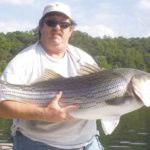
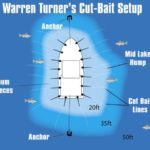
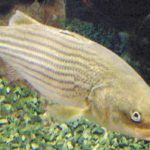
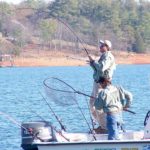

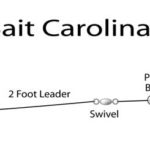



Be the first to comment